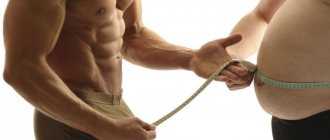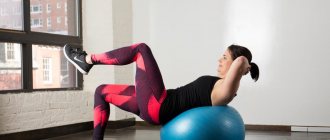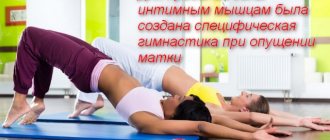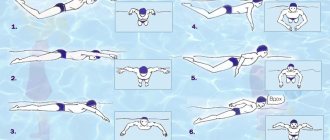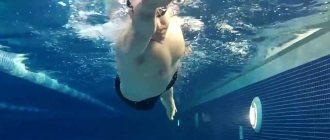In rock paintings you can often see a person performing swimming movements with his hands. At the same time, they resemble movements from the breaststroke style of swimming. This style of swimming appeared more than ten thousand years ago. Today it is one of the most popular swimming styles, mastered by both children and adults. This style of swimming is included in the program of the Summer Olympic Games and gives many athletes the opportunity to climb to the Olympic podium.
Concept
Breaststroke (from the French brass - “hand”) is one of the oldest swimming styles, which is both complex in technique, fast and easy to overcome long distances.
Breaststroke is a style of breast swimming in which the swimmer makes simultaneous and symmetrical movements of the arms and simultaneous and symmetrical movements of the legs in a horizontal plane under the surface of the water.
Anyone can swim breaststroke, regardless of age. Swimming always brings many benefits to the body, regardless of the style used.
Exercising in water is always a new charge of vivacity and a good mood, which is accompanied by improved well-being. Breaststroke swimming has a positive effect on the entire vital system of the human body.
Breaststroke improves blood circulation, strengthens blood vessels, and the cardiovascular system works as one well-coordinated mechanism. The respiratory system also receives a lot of benefits from exercise. The lungs work to their full capacity, and there are no problems with the bronchi and trachea for a long time.
Breaststroke brings great benefits to the muscles. Active movements of the arms and legs strengthen the entire muscle group. Active swimming affects the vertebrae. This allows you to form beautiful posture and get rid of scoliosis and other problems with the spine.
Of course, swimming is an opportunity to build a slim figure. Breaststroke actively helps with this. The movements of this style are quite complex and require a lot of energy. At the same time, the same movements, due to the technique of their implementation, allow you to stay in the water for a long time, which means burning more calories.
How to swim correctly?
This style is one of the most difficult from a technical point of view. Therefore, before reading the text description, look at how it looks from the outside:
As you can see, the following movements are performed :
- the arms make a stroke and are thrown back forward;
- during the stroke, the head rises above the water and inhales, then lowers and exhales;
- at the moment the arms are thrown out, the legs make a push, similar to the movements of a frog, due to which the body receives additional acceleration and slides until the next stroke.
For a better understanding, we also recommend watching this slow motion video:
Now let's look at the technique step by step and in detail.
Hand movements step by step
Initial position:
- the arms, like the whole body, are fully extended and straightened , as shown in the illustration above;
- palms are located next to each other, almost at the surface of the water;
- head is lowered into the water.
In the pool, you can push off the side with your feet and slide forward on your chest in this position.
From the starting position, a cycle of hand movements is made, which can be divided into three phases.
At the same time, one action always transitions into another, there are no pauses - therefore, the instructions below, divided into phases, are very conditional - such a division was made only to make it easier to describe and understand the technique.
Lateral spread
Hands, palms out, are spread to the sides approximately slightly wider than shoulders.
At this stage, the arms sink a little and bend a little - overall still remaining straight. The movement is done with the palms perpendicular to the bottom and turned outward - imagine that we are moving the water with them.
The movement itself happens quickly - it’s just spreading the hands for the next stroke.
In the illustration, this stage goes up to the first red arrows:
Rowing
- Main part of the stroke:
The brushes are rotated so that palms looked down again. Hands bend at the elbows and do strong rowing movement towards oneself - to pull the body forward and upward.During this step, the elbows gradually rise up and move out to the sides.
The rowing movement continues approximately until the palms are in line with the shoulders .
As we apply the effort, the head and shoulder girdle come out above the water - read about this below.
- Completion of the stroke:
At the moment of the end of the stroke, the hands close at the chest: - elbows approach the body in the area of the ribs,
both hands are placed next to each other so that the palms are facing the body (in the chin area).
Forward ejection
Ejection moment
- The hands (previously brought together in the chest area) are sharply thrown forward to return to their original position - to be extended in front of them.
- At the very end of the ejection, the brushes unfold. That is, initially they go with their palms up (palms facing the chin), at the end of the palm they turn towards the bottom - towards the bottom.
Hand Throw Options
The task of this stage is not only to return to the starting position, but also to do this with minimal resistance from the water , to give your body an impulse to move forward, to begin sliding through the water.
Therefore, this action has two options :
- Return over water - this technique is considered the most effective and is used by many professionals at sprint distances.
The point is that we throw our hands back not under water, but above its surface and thereby do not slow down against the water. However, this movement requires much more effort, if you are swimming a long distance or are not physically prepared for such a technique, then the second option should be used. - Underwater Return – Here they return underwater/on the surface line. As was indicated, in this option we slow down our progress somewhat, but physically it is easier to act this way.
After returning the hands, there is always a sliding stage, we will talk about this below.
Correct and incorrect options
The options for incorrect (but common) and correct strokes are perfectly shown in this short video:
Alternative way
Watch a swimmer swim in this video:
- during the return, the hands do not turn with the palms facing the chest;
- the swimmer throws them out underwater.
We won’t undertake to say how optimal this technique is, but this is exactly what the professionals demonstrate in this video.
Back breaststroke technique
Body position
- The swimmer lies on his back, parallel to the surface of the water.
- The body is elongated in a straight line.
- Legs straight, brought together.
- Arms are straightened, thrown back.
- Palms face up.
- The face remains above the water column. The chin is slightly pressed to the body.
Hand movement
Hands seem to cut through water. The position of your palms helps regulate flow and speed up.
Step by step execution:
- Sliding from the starting position. The body is in the starting position, hands behind the head.
- Rowing Hands with clenched fingers are bent. Hands are moved to the sides, down. During the stroke itself, the palms open. As soon as the hands touch the hips, the stroke is complete.
- Carrying. The hands are moved through the air to the starting position.
Leg movement
The push is performed by sharply straightening the legs.
Technique:
- Starting position. Knees bent.
- Feet are spread shoulder-width apart, heels pointing outward.
- The heels are lowered until they are as close to the pelvis as possible.
- The legs are spread, the feet are turned outward. The legs forcefully return to their starting position. The movement occurs from bottom to top in arcs, and then towards each other.
Correct breathing
Inhalation occurs at the end of the stroke, before the movement begins. Exhale during the stroke itself. Exhale through the mouth and nose, inhale only through the mouth.
Motion synchronization
While swimming:
- inhale after the stroke;
- the push occurs at the same time as the hands are lowered into the water;
- when returning to the starting position, exhale, then slide.
Footwork
The legs first pull up , then push , as shown in this illustration:
In addition to the illustration, correct footwork can also be seen in this video tutorial:
The footwork is synchronized with the movements of the arms (this is the main difficulty of the breaststroke technique - making movements synchronously and in a timely manner).
It can be roughly divided into two stages, although it is important to note here that there is no pause or hitch between them: as in the case of the hands, this is a single action.
Leg pull-up
Performed towards the end of the stroke - you need to tighten your legs for the subsequent push, while:
- the knees should still remain closed - next to each other,
- Spread your shins to the sides, turn your feet outward and pull them towards you to push off the water. Ultimately, your feet should be wider apart than your knees.
Coordination of pulling up with hands occurs as follows:
- during the stroke itself, a smooth pulling of the legs begins,
- when the arms are brought forward (closed at the chest) - the legs are pulled up and spread for the subsequent push.
Push
It is performed at the moment of throwing the arm forward - a sharp striking movement is made with the legs.
The meaning of the technique is that we throw out our arms and legs at the same time - so that the body quickly and completely straightens and slides forward due to the impact movement.
To push, the legs kick to the sides (in the direction where the feet were pointing after we pulled them up). The blow is made by straightening the leg.
Immediately after the end of the striking movement, the legs, being straightened, relax and close together, the feet are extended. The whole body from arms to feet stretches in one line and slides.
The synchronization of arms and legs is clearly visible in this slow-motion video demonstrating the technique of world champion Brenton Rickard:
Breathing and body movements
Main article: How to breathe in breaststroke
Inhale
At the moment of the stroke, the upper part of our body (shoulder girdle) rises above the water , including the head.
In this case, it is recommended to make a wave-like movement with the neck and upper body, which helps to go out, and then return back (the diving movement is as important here as the emerging movement).
When the head appears above the surface of the water, a sharp breath is taken through the mouth .
Exhalation
At the moment of throwing out the arms and pushing the legs, the body and after it the head are extended and take a horizontal position. The face, accordingly, falls back into the water.
Next comes exhalation , it is done with your nose into the water , and if you are swimming intensely and do not have time to exhale all the air from your nose, then with your mouth .
The exhalation proceeds without delay throughout the entire movement and ends by the time you need to inhale again.
Breathing in breaststroke
Examples of exercises
Sliding movements in a supine position on the surface of the water with arms extended forward, raising the head, holding your breath. Rehearsing kicking movements with legs.
Diving under water with holding your breath and suddenly jumping out of the water, inhale and exhale - the next dive - without pauses, 10 times in a row.
Diving with exhalation under water - 10 times or more.
Before you start swimming, you need to warm up your muscles. While swimming, the athlete must be focused and not be distracted by extraneous matters. The workout should not exceed 1.5 hours, but should not take less than 40 minutes. The duration increases gradually. Their number is at least three per week.
The load increases with increasing endurance. Do not eat food immediately before or after class. The last meal is an hour before going to the pool.
Slip
Breaststroke, like other swimming styles, is primarily characterized by the fact that its main element is gliding through the water.
Therefore, after throwing out the arms with a kick, the sliding phase begins - the fully extended body must slide through the water, while:
- the faster you swim, the smaller this phase will be (but it will still be present);
- if you swim in power saving mode, then the glide, on the contrary, will be long.
Regardless of the speed and goals of swimming, during practice, be sure to find and feel this sensation - how your body glides.
Video lesson on proper swimming
You can understand the breaststroke swimming technique in detail using the following video.
In it, the famous swimmer and multiple Russian swimming champion Danil Antonenkov explains step by step all the nuances of breaststroke swimming techniques on the front and back, and also tells how to swim breaststroke quickly.
Swimming is a great way to tone your body , make it strong and beautiful, and breaststroke swimming will also greatly strengthen your respiratory system.
What style of swimming do you prefer? Maybe you are still wondering how to learn to swim breaststroke? Ask your questions in the comments!
Bugs in the pool
- Swimming with your head up. This is perhaps the most serious and harmful mistake - you not only slow down your progress, depriving your body of the aforementioned sliding, but also overload the cervical spine, which can lead to injuries and diseases.
- Raising the knees to the sides. It is a mistake to spread your knees to prepare your legs for kicking, as shown in this illustration:
They should be closed both at the moment of pulling the legs and at the moment of spreading the feet - and only at the moment of impact do the legs straighten and the knees, accordingly, diverge. - A weak kick with your feet. Proper foot technique means that he must be strong and sharp .
- General incoordination of movements. Coordination of movements, as stated, is the most important thing in breaststroke technique. If you push your legs too early or too late, all the effectiveness of this style will be lost.
- Hands do not cling to the water and do not rake it. Hands should not just move in the water, but rather lean on it and rake it. This error is shown in the illustration below:
- Putting your hands behind your back. During the stroke, the arms should reach the shoulder line and then be thrown out. If you bring them too far, then, on the one hand, the stroke will be more powerful, but at the same time it will be more difficult to return, and the effectiveness of the technique will decrease.
Additional nuances
- If you swim underwater , then you can do strokes like in breaststroke, only do not stop your hands at the shoulder line, but bring them to your hips - this way the stroke will be stronger. In “classical” swimming at competitions, such a movement is allowed to be made once per pool - respectively, after the start or turn.
- If you are competing in speed competitions, you don't have to take a breath every time, but the rule is that your head should still cross the surface of the water during each cycle.
- At the very beginning , you can practice on land on a bench to understand the coordination and synchronization of movements.
- Breaststroke is inferior in speed to crawl, and at short distances it is generally inferior to all other swimming styles.
- At the same time, breaststroke requires less energy than crawl, and especially than butterfly.
- A non-obvious feature: if your goal is to swim as quietly as possible (in terms of loud sounds), then breaststroke is better suited for these purposes.
The undeniable benefits of swimming
Swimming breaststroke brings significant benefits to the body:
- Breaststroke swimming technique requires proper breathing, which helps stimulate and strengthen the respiratory system and develop the lungs.
- Prolonged contact with the aquatic environment provides a massage effect on the skin of the body, improving blood circulation in it, and also helps cleanse the skin.
- Active blood circulation, which begins during swimming, completely eliminates stagnation of blood and other fluids in the body, and also helps strengthen the walls of blood vessels and train the heart muscle.
- Regular contact with water helps strengthen the body's immune and nervous systems, improves mood and eliminates stress.
- In half an hour of breaststroke swimming, the body consumes about 270 calories of energy, which is significantly higher than in any other sport.
- The breaststroke style helps strengthen muscle groups such as the muscles of the shoulder girdle, arms, abs, as well as the buttocks and thighs. That is, it addresses the main problem areas of most people who want to lose weight.
- Breaststroke swimming has a positive effect on posture and smoothness of movements - they become fluid and graceful.
- Breaststroke is great for pregnant women - it helps strengthen the groin and leg muscles, which can make labor much easier later on.
If you are interested in other swimming styles, or you want to find out for yourself which swimming style is better - crawl or breaststroke, pay attention to our article “Freestyle swimming technique”.

